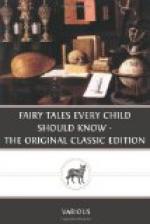“Tell me what it is.”
“Will you promise to let me have it?”
The king was on the point of saying yes, but the wiser queen checked him with a single motion of her head.
“Tell me what it is first,” said he.
“No, no. Promise first.”
“I dare not. What is it?”
“Mind, I hold you to your promise. It is—to be tied to the end of a string—a very long string indeed, and be flown like a kite. Oh, such fun! I would rain rose-water, and hail sugar-plums, and snow whipped-cream, and—and—and—”
A fit of laughing checked her; and she would have been off again over the floor, had not the king started up and caught her just in time. Seeing that nothing but talk could be got out of her, he rang the bell, and sent her away with two of her ladies-in-waiting.
“Now, queen,” he said, turning to her Majesty, “what is to be done?”
“There is but one thing left,” answered she. “Let us consult the college of Metaphysicians.”
“Bravo!” cried the king; “we will.”
Now at the head of this college were two very wise Chinese philosophers—by name Hum-Drum, and Kopy-Keck. For them the king sent; and straightway they came. In a long speech he communicated to them what they knew very well already—as who did not?—namely, the peculiar condition of his daughter in relation to the globe on which she dwelt; and requested them to consult together as to what might be the cause and probable cure of her infirmity. The king laid stress upon the word, but failed to discover his own pun. The queen laughed; but Hum-Drum and Kopy-Keck heard with humility and retired in silence.
Their consultation consisted chiefly in propounding and supporting, for the thousandth time, each his favourite theories. For the condition of the princess afforded delightful scope for the discussion of every question arising from the division of thought—in fact, of all the Metaphysics of the Chinese Empire. But it is only justice to say that they did not altogether neglect the discussion of the practical question, what was to be done.
Hum-Drum was a Materialist, and Kopy-Keck was a Spiritualist. The former was slow and sententious; the latter was quick and flighty; the latter had generally the first word; the former the last.
“I reassert my former assertion,” began Kopy-Keck, with a plunge. “There is not a fault in the princess, body or soul; only they are wrong put together. Listen to me now, Hum-Drum, and I will tell you in brief what I think. Don’t speak. Don’t answer me. I won’t hear you till I have done. At that decisive moment, when souls seek their appointed habitations, two eager souls met, struck, rebounded, lost their way, and arrived each at the wrong place. The soul of the princess was one of those, and she went far astray. She does not belong by rights to this world at all, but to some other planet, probably Mercury. Her proclivity to her true sphere destroys all the natural influence which this orb would otherwise possess over her corporeal frame. She cares for nothing here. There is no relation between her and this world.




